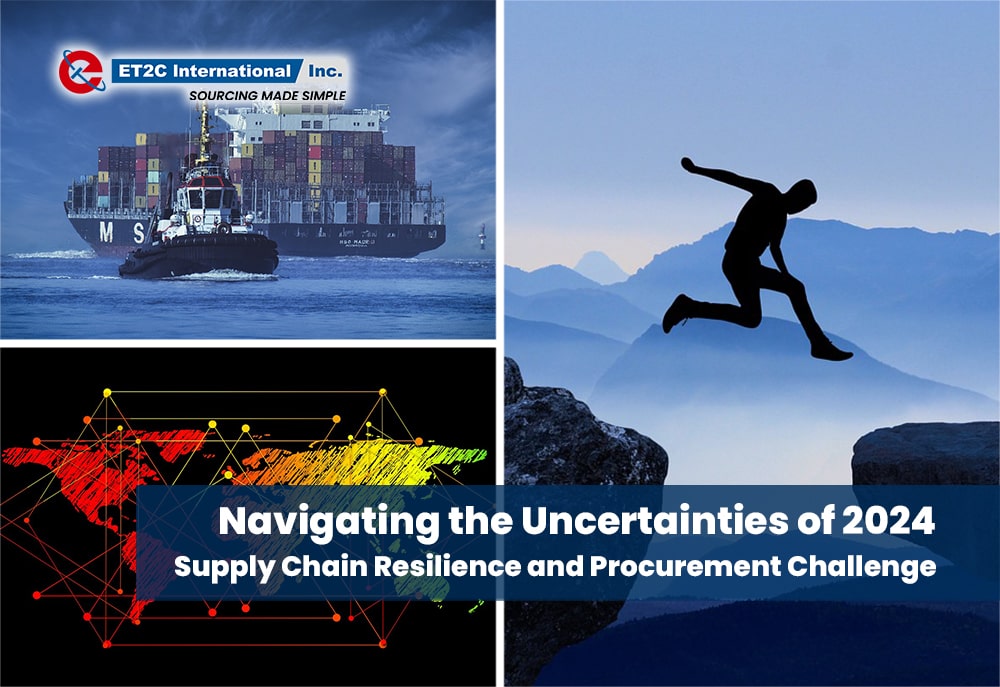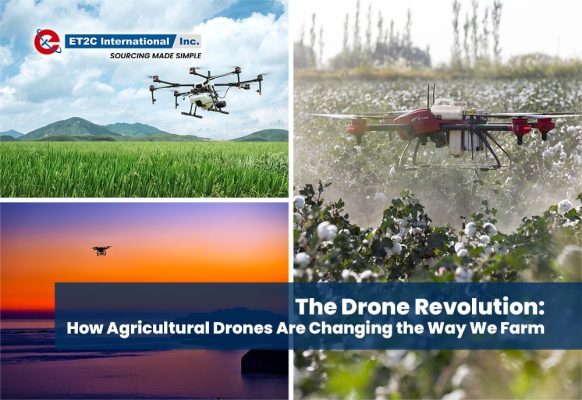Asia & Global Sourcing Revolution: Diversify Your Sourcing with Buying Offices in Emerging Markets
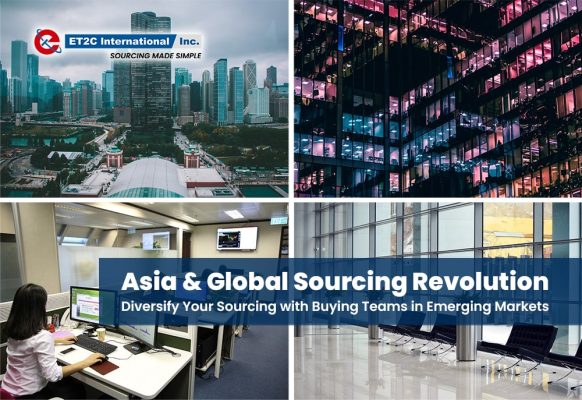

Looking to source and procure products beyond China? Explore the potential of Southeast Asia’s emerging sourcing markets by establishing buying offices in market for a more effective, agile and resilient supply chain.
The winds of change are blowing through global supply chains. The once-dominant position of China as the world’s manufacturing hub is facing increasing scrutiny. Companies are re-evaluating their global sourcing strategies, with a growing emphasis on diversification, risk mitigation, reduced shipping times and environmental impacts.
This blog post delves into the reasons behind this shift and explores how buying offices can navigate the complexities of spreading their sourcing base across different countries.
ET2C International Unique Buying Office Model
ET2C International have over 23 years’ experience as Global Sourcing Experts. Our 200 colleagues are based in 7 offices across developed and emerging Asian sourcing markets to be your feet on the round. Creating your bridge to your Asian supply partners.
Many of our clients have developed their dedicated Asian buying offices with us. Taking advantage of our unique model that mitigates all the risk of establishing a dedicated team whilst releasing all the benefits of a team on the ground and direct supply relationships. Removing the challenges of office space, recruitment, staff isolation, HR, Payroll and Legal in a simple solution. Our teams can rapidly establish dedicated teams in China, India, Vietnam and Turkey to rapidly take your Global Sourcing to the next level. Buying Office Model
To find our more about our unique Asian Buying office model drop us a line at contact@et2cint.com

Why Diversification is Becoming the New Mantra for Global Sourcing and Procurement teams
Beyond Cost:
While China has historically offered significant cost advantages, factors like rising labour costs, trade tensions including tariff wars and WTO disputes are prompting companies to look beyond the bottom line.
Supply Chain Resilience: The COVID-19 pandemic exposed the vulnerabilities of over-reliance on a single source and Just in time supply chains. Companies are now prioritizing supply chain resilience, seeking to spread their sourcing risk across multiple countries. Reducing shipping times and building closer partnerships between company and supplier.
Geopolitical Instability: Rising geopolitical tensions and potential trade wars are influencing global sourcing strategies. Companies are seeking to mitigate risks associated with dependence on a single region. Post Pandemic disputes lodged with WTO have increased dramatically creating further pressures on the previously smooth-running global trade network
Consumer Preferences: Consumers are increasingly concerned about ethical sourcing practices, environmental sustainability, and product quality. Diversification can help companies address these concerns by sourcing from countries with strong ethical and environmental regulations. Reducing corporate and product risk and measuring and reporting on environmental impacts.

Benefits for Sourcing and Procurement teams of Diversifying Sourcing Locations
Reduced Risk: Spreading your sourcing base minimizes the disruption caused by unforeseen events in a single country. Natural disasters, labour strikes, or political instability can have a lesser impact on your overall supply chain.
Improved Negotiation Power: By sourcing from multiple countries, you gain leverage in negotiations with suppliers. Increased competition among suppliers can translate to better pricing and contract terms.
Access to New Markets: Diversifying can open doors to new markets with specific skillsets or resources. This allows you to tap into a wider range of supplier expertise and potentially source unique products.
Enhanced Innovation: Exposure to diverse manufacturing environments and cultural perspectives can foster innovation. Close collaboration with suppliers in different countries through a dedicated local team can develop new ideas and product development opportunities.
Improved Brand Perception: Demonstrating a commitment to responsible sourcing by diversifying across countries with strong ethical and environmental standards can positively impact your brand image whilst reducing the potential for corporate reputational risk.
Challenges of rapidly establishing a dedicated sourcing and procurement team in new markets
Increased Complexity: Managing a geographically dispersed supply chain requires more complex logistics, communication, and quality control measures.
Hidden Costs: Setting up operations in new countries may involve initial costs for establishing relationships with suppliers, navigating regulations, and adapting to different business cultures.
Quality Control Challenges: Maintaining consistent quality across multiple suppliers in different countries requires robust quality control processes and a strong local presence.
Longer Lead Times: Managing logistics across different countries can potentially lead to longer lead times, requiring careful planning and inventory management.
Cultural Differences: Communication and collaboration can be more challenging due to cultural differences, language barriers, and varying business practices across countries.

How Buying Offices Can Facilitate Diversification: Whilst delivering Commercial Competitive advantage benefits
- Market Research and Supplier Identification:
Buying offices can conduct in-depth research to identify potential sourcing locations that align with your company’s needs and values. They can leverage their local expertise to source reliable and ethical suppliers in different countries.
- Supplier Qualification and Negotiation:
Experienced buying offices can evaluate potential suppliers based on factors like quality, capacity, pricing, and adherence to your ethical sourcing standards. They can negotiate competitive contracts and manage supplier relationships in the local language.
- Quality Control and Compliance:
Maintaining consistent quality is crucial. Buying offices can conduct on-site inspections at your suppliers’ facilities, ensuring adherence to your quality standards and relevant regulations. They can also assist with navigating customs procedures and import/export regulations.
- Logistics Management:
Efficient logistics are essential for a diversified supply chain. Buying offices can manage freight forwarding, customs clearance, and ensure timely delivery of goods from various countries.
- Cultural Bridge and Communication:
Cultural sensitivity is key. Buying offices can bridge the cultural gap between your company and your suppliers in different countries, facilitating smooth communication and fostering productive working relationships. …
Unlocking Asian Sourcing: Benefits, Risks & Why a Buying Office could work for you

The Growth and Development of sourcing in Asian and China
The allure of Asia’s vast manufacturing base, skilled workforce, and cost-competitiveness has prompted many European and North American companies to explore sourcing opportunities in the region. Global Sourcing from China or wider Asians markets has always been a source of huge competitive advantage for companies in many industries.
From start-ups to multinational organisations building Supply Chain to encompass offshoring has been a corner stone of margin delivery and competitive advantage. However, as more companies start to recognise and develop their Asian sourcing or Global sourcing strategies. The immediate first stage benefits are beginning to be degraded removing some of the early mover advantages.

Establishing a Buying Office in Asia can be a strategic move to enhance Sourcing Capability
Establishing a team in market can deliver significant advantages over working through an agent or trying to manage relationships directly from Head Office.
Whilst the Advantages can be huge the challenges of office space, recruitment, HR and Legal in a new country or jurisdiction can seem insurmountable and full of complexity.
ET2C International Unique Buying Office Model
ET2C International have over 23 years’ experience as Global Sourcing Experts. Our 200 colleagues are based in 7 offices across developed and emerging Asian sourcing markets to be your feet on the round. Creating your bridge to your Asian supply partners.
Many of our clients have developed their Asian buying offices with us. Taking advantage of our unique model that mitigates all the risk of establishing a new entity whilst releasing all the benefits of a team on the ground and direct supply relationships. Removing the challenges of office space, recruitment, staff isolation, HR, Payroll and Legal in a simple solution. Our teams can rapidly establish Buying Office teams in China, India, Vietnam and Turkey to rapidly take your Global Sourcing to the next level. Buying Office Model
To find our more about our unique Asian Buying office model drop us a line at contact@et2cint.com

The Advantages of Establishing a Buying Office in Asia:
The balance of benefits will be dependent on your current sourcing and procurement model.
- Cost Reduction: A key advantage is the potential for significant cost savings. Asian countries often offer lower labour costs, raw material prices, and production overheads compared to Europe and North America.
- Enhanced Quality Control: A local presence allows for closer collaboration with suppliers, facilitating improved quality control measures throughout the production process. Regular on-site inspections and communication can minimize defects and ensure adherence to quality standards.
- Efficient Sourcing & Negotiation: A dedicated buying office can identify new suppliers, negotiate better pricing based on local market knowledge, and manage sourcing activities efficiently.
- Improved Speed to Market: Having a local team facilitates faster communication and quicker response times with suppliers. This can lead to shorter lead times and faster product introductions in your markets.
- Supply Chain Visibility & Management: A buying office can provide real-time information on production progress, inventory levels, and potential disruptions within the supply chain. This allows for proactive management and mitigation of risks.
- Regulatory Compliance: Navigating the complexities of Asian regulations can be daunting. A local team can ensure compliance with product safety standards, import/export regulations, and labor laws.
- Cultural Understanding & Communication: An Asian buying office fosters better cultural understanding between the company and its suppliers. This bridges communication gaps, avoids misunderstandings, and strengthens business relationships.
- Direct Access to Asian Markets: A physical presence allows companies to explore opportunities for selling their own products within the Asian market itself, potentially creating a new revenue stream.
The benefits can be huge and wide ranging in establishing your team on the ground. The Risks are the factors holding back many companies from releasing the Operational benefits. Mitigation of these is crucial to effective implementation.
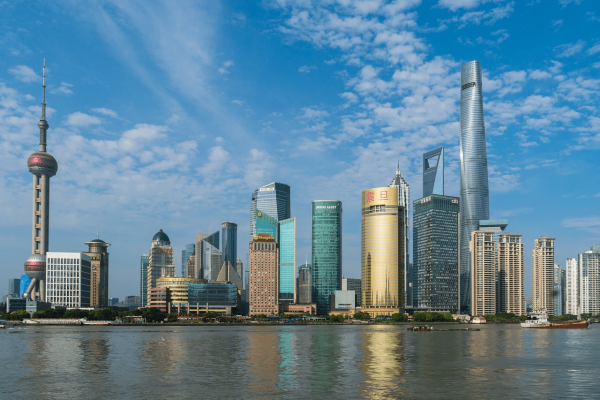
Risks to be Mitigated in establishing a Buying Office in Asia:
- Investment: Establishing a buying office requires an initial investment in setting up the office space, hiring staff, and legal compliance. Simply finding office space of the right standard can require significant time and market knowledge.
- Skill Sets: Many organisations do not have the current capability to navigate employment law, practises and legality in a new jurisdiction.
- Cultural Differences & Language Barriers: Cultural differences and language barriers can lead to communication difficulties, misunderstandings, and potential delays in operations.
- Labor Regulations & Ethical Sourcing: Navigating complex labor laws and ensuring ethical sourcing practices can be challenging for companies unfamiliar with the Asian landscape.
- Distance & Time Zone Differences: Managing a team across a significant time zone difference can pose communication and operational challenges This can build a feeling of isolation and remoteness in working reducing effectiveness.

ET2C International Unique Buying Office Model-What are the Benefits
- Local Expertise & Knowledge: Setting up a buying office requires navigating complex legal, cultural, and business environments. Companies often lack the in-depth knowledge and experience to navigate these challenges effectively. Our 23 years experience and teams on the ground in China and other Asian Sourcing markets enable us to rapidly deliver:
- Office space: Our modern office facilities ensure great working environment and the ability for your teams to network with other Buying teams within the same building. Sharing knowledge and building Insights
- Recruiting & HR: We manage all your recruitment with you to find qualified local staff, managing payroll, and adhering to labour regulations.
- Supplier Identification & Negotiation: Identifying reliable suppliers, negotiating competitive pricing, and managing vendor relationships.
- Quality Control & Inspection: Providing quality control support and overseeing production processes.
2. Faster Start-Up Time: Companies can leverage our existing infrastructure and resources, leading to the quicker establishment of their buying office and streamlined operations.
The benefits of setting up your Asian Buying Office
Moving your Global Sourcing Strategy to one with Buying Office established moves your delivery to the next level. Improving operating margins, developing faster innovation, improving quality and supplier relationships. When establishing your new office risk mitigation is crucial to ensure rapid margin and trading improvements.
Buying Office Model has been delivering benefits to our clients for over 10 years. Mitigating all the risk of setting up a team in Asian to allow them to focus completely on delivering the benefits to operating margins. To find out more about how this could elevate your Global Sourcing drop us a line contact@et2cint.com
Unlocking Asian Sourcing: Benefits, Risks & Why a Buying Office could work for you Read More »
Summer Davos 2024: Cooperation in a Turbulent Global Trading World

The 15th Annual Meeting of the New Champions, also known as Summer Davos 2024, concluded in Dalian, China, on June 27th, 2024. Held under the theme “Next Frontiers for Growth,” the forum brought together over 1,700 participants from nearly 80 countries and regions. This year’s event was particularly significant, taking place amidst global economic uncertainty and a renewed focus on climate action.

Key Outcomes and Deliverables: Fostering Trust, Driving Sustainability
Summer Davos 2024 yielded several noteworthy outcomes that promise to impact global progress on various fronts. These include:
- China’s Economic Growth and Future Trajectory: Chinese Premier Li Qiang addressed the forum, highlighting China’s economic growth exceeding expectations at 5.3% in Q1 2024. However, discussions acknowledged the need for a more sustainable and innovative model for long-term growth. This focus on responsible development within China’s vast market has implications for global sourcing companies. As China prioritizes environmental sustainability and green practices, global sourcing may shift towards ethically produced goods with a lower environmental footprint.
- Expansion of the First Movers Coalition: This initiative, launched at COP26, aims to create a market for clean energy technologies. Summer Davos witnessed its expansion to nearly 100 companies, including giants like IKEA and Maersk. This signifies a growing international commitment to accelerating the development and adoption of clean technologies. This expansion could lead to increased demand for clean energy solutions from a wider range of global sourcing companies, potentially impacting supply chains and trade flows.

- Progress on the 1t.org Platform: This ambitious platform aims to conserve, restore, and grow one trillion trees by 2030. At Summer Davos, over 100 companies pledged to plant 12 billion trees, a significant step towards achieving the platform’s goal. Increased collaboration on reforestation efforts could create new opportunities for global sourcing companies specializing in sustainable forestry practices and related technologies.
- Launch of the Network to Mobilize Clean Energy Investment for the Global South: This critical initiative aims to connect developing economies with resources and expertise for their energy transition. Developed nations and global sourcing companies can leverage this network to increase clean energy investments in the Global South. This can lead to the creation of new markets for clean energy technologies, fostering sustainable development and potentially creating new sourcing opportunities for ethically produced goods from these regions.
- Mental Health in Cities: Experts identified 37 characteristics of a “mental health-friendly city.” These insights can guide urban planning and policy decisions around the world, contributing to the well-being of citizens and potentially improving overall productivity within global sourcing hubs.

Impact on Global Sourcing and Procurement
The outcomes of Summer Davos 2024 have the potential to influence global trade in several ways:
- Shift Towards Green Practices: The forum’s emphasis on sustainability and clean energy initiatives could lead to a rise in demand for environmentally friendly products and technologies, reshaping global trade patterns and impacting the sourcing strategies of companies worldwide.
- Focus on Innovation: China’s pledge to prioritize innovation paves the way for new industries and technologies with global trade implications. This could lead to new sourcing opportunities for innovative products and solutions.
- Investment Opportunities: The Network to Mobilize Clean Energy

ET2C International Global Sourcing Experts
The ET2C International is a UK managed Global Sourcing company with over 22 years trading experience. Our 200 colleagues are based in offices in 7 countries across Asian and emerging markets from China to India to Turkey. Ensuring we are always well placed to support our clients strategic sourcing and procurement challenges. ET2C Corporate Profile
The latest Summer Davos shows the both the challenges in Global Trading and Supply but also the growth of Sustainability as a key plank of Sourcing Strategies.
If you would like to know more about how you can improve Sustainability in your Sourcing Strategy or to discuss emerging supply markets please drop us a line contact@et2cint.com
Summer Davos 2024: Cooperation in a Turbulent Global Trading World Read More »
Navigating the Uncertainties of 2024: Supply Chain Resilience and Procurement Challenges
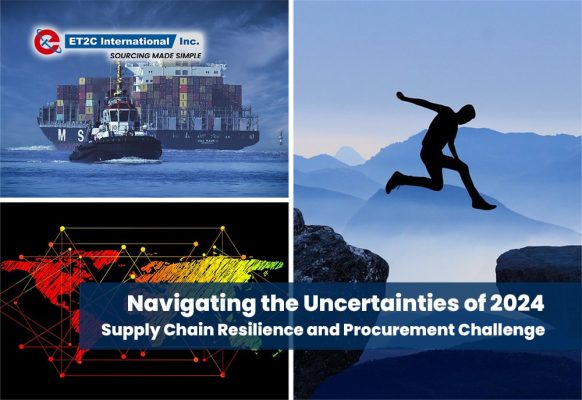
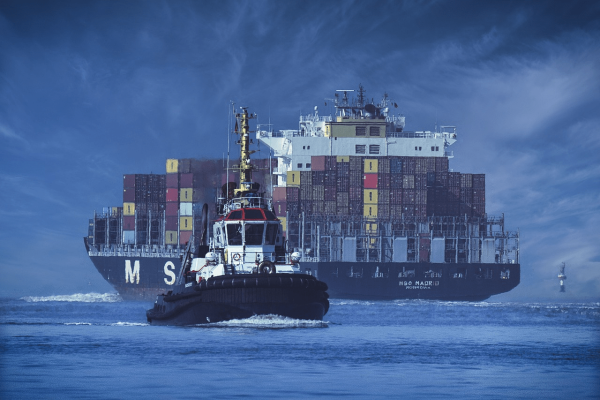
Global Sourcing and Supply Chain Challenges in 2024
The global supply chain has endured a decade of disruptions, from the US-China trade war to the COVID-19 pandemic and the ongoing Russia-Ukraine crisis. While some semblance of normalcy has returned in operational terms, 2024 is poised to present new challenges that will test the resilience of businesses and supply chain management professionals. Businesses and supply chain professionals need to adopt a proactive and strategic approach to enhance resilience, effectively leverage technology, foster organizational agility, build strong supplier relationships, and prioritize long-term investments.
Developing Sourcing and Supply Chain Resilience Under Pressure
The demand for a more resilient supply chain is paramount, but the willingness and ability of corporations to invest in fortifying their networks remain uncertain. Technology holds immense potential to enhance resilience, with generative AI emerging as a promising tool. However, the emphasis on short-term returns on investment and mixed experiences with blockchain technologies have dampened enthusiasm for such investments.

Investing in Resilience in a Costly Environment
The economic landscape is challenging, with shrinking corporate profit margins and higher capital expenditures. This may prioritize reinvestment in capital stock over supply chain investments in 2024. Companies need to carefully evaluate the return on investment for resilience-enhancing technologies, particularly in the current economic climate.
Technology Toolkit for Enabling Sourcing and Supply Chain Resilience
Deploying technology strategically is crucial for enabling supply chain resilience. While large enterprises may have the resources to experiment with emerging technologies, most players will only invest in digital transformation if it delivers a clear and near-term return on investment.
Delivering Supply Chain Resilience through Organizational Agility
Building a robust supply chain is an ongoing process, requiring adaptability and proactive measures. This may involve adjustments to inventory policies, embracing new technologies, optimizing supplier networks, and diversifying sourcing strategies.
Resilience Still Needed, Spending Not Guaranteed
The need for supply chain resilience remains as pressing as ever, but financial constraints and the prioritization of other investments may limit corporate spending on resilience-enhancing initiatives in 2024. Companies need to carefully balance short-term financial needs with long-term supply chain security.
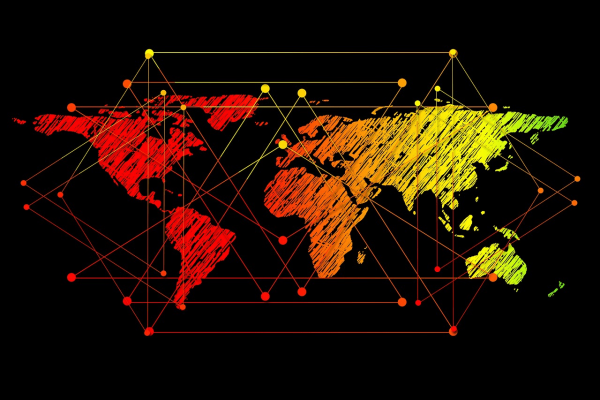
Navigating the Challenges of Global Sourcing and Supply Chain
In the face of these challenges, supply chain and procurement professionals must adopt a proactive and strategic approach. This includes:
- Closely monitoring industry trends and potential disruptions:Companies need to stay abreast of emerging risks and develop contingency plans to mitigate their impact.
- Leveraging technology effectively:Identifying and implementing technologies that demonstrate clear return on investment and align with overall business goals.
- Promoting organizational agility:Fostering a culture of adaptability and proactive risk management within the organization.
- Building strong supplier relationships:Nurturing long-term partnerships with suppliers that share the commitment to resilience and quality.
- Prioritizing long-term investments:Recognizing the value of resilience-enhancing initiatives, even if they may yield slower returns in the short term.
By addressing these challenges with a combination of strategic planning, technology adoption, and organizational agility, businesses can navigate the uncertainties of 2024 and build supply chains that are more resilient and better prepared to withstand future disruptions.
ET2C International is an Expert in Sourcing and Supply Chain
ET2C International has for over twenty years played a crucial role connecting global brands and companies with sourcing partners. Our expertise in global sourcing and supply chain can make sure you get all the benefits of sourcing from China and Asia without any of the risks.
Our 250 colleagues are based in offices in seven key Asian sourcing markets to make your global sourcing simpler. Where language, time zone or business communication practices can make things difficult, our team will be your bridge to your suppliers.
Our team of experts can help you build and deliver your diversification strategy. Giving you independent feet on the ground and confidence with fast responses, removing time zone and language challenges.
Supply chain diversification is not a one-size-fits-all strategy. The optimal approach will vary depending on the industry, product type, and risk tolerance of each organization. However, by carefully evaluating their supply chain and implementing targeted diversification strategies, businesses can enhance their resilience, agility, and competitive advantage in the ever-evolving global marketplace.
If you would like to explore opportunities or to discuss how we can help you to diversify your supply chain, please contact@et2cint.com
Navigating the Uncertainties of 2024: Supply Chain Resilience and Procurement Challenges Read More »
The Drone Revolution: How Agricultural Drones Are Changing the Way We Farm
The Growing use of Drone in Agriculture
In the ever-evolving landscape of modern agriculture, the buzz is not just from the bees but also from the increasingly prevalent hum of drones. Unmanned aerial vehicles, commonly known as drones, have swiftly become indispensable tools for farmers worldwide. Drones are rapidly moving from being high tech devices to vital tools on many farms supporting productivity and profitability for farmer and growers. Where is there use and adoption moving fastest and what factors will have to be overcome to continue to deliver strong growth across all regions. From improving crop yields to reducing costs, drones can help farmers to optimize their operations and produce more food with fewer resources.
The Rise of Agricultural Drones:
The agricultural sector is experiencing a technological revolution, and drones have emerged as a game-changing innovation. These aerial devices equipped with cameras and sensors are providing farmers with a bird’s-eye view of their fields, enabling them to make informed decisions, optimize resource use, and enhance overall efficiency. Starting as a way of doing easy and effective crop reviews, drones have rapidly widened their capabilities to be capable of spraying, pest control and precision agriculture large fields easily. This increased functionality together with technological developments have seen the the rapid adoption of drones across many regions but extended the capabilities of drones to be multi-functional.

Markets and Countries Leading the Adoption of Agri Drones:
- United States:
– The U.S. has been at the forefront of adopting agricultural drone technology. Large-scale farms in the Midwest, vineyards in California, and various crop producers across the country have integrated drones into their farming practices. The expansive agricultural landscape and the pursuit of precision farming contribute to the widespread adoption.
- China:
– China, a global agricultural powerhouse, has rapidly embraced drone technology in farming. The government’s support for technological innovation, coupled with the vast expanse of farmland, has fueled the adoption of drones for crop monitoring, pest control, and precision agriculture.
- Brazil:
– Brazil’s vast agricultural acreage, including extensive soybean and sugarcane fields, has made it a key player in the adoption of agricultural drones. Brazilian farmers leverage drones for crop monitoring, assessing soil health, and optimizing irrigation practices.
- Japan:
– Japan, with its tradition of technological innovation in agriculture, has been an early adopter of drones. Farmers use drones for tasks such as rice planting, spraying pesticides, and monitoring crop health in terraced fields.
- Australia:
– Australian farmers, facing challenges like drought and vast expanses of land, are turning to drones for water management, crop monitoring, and livestock surveillance. The country’s progressive approach to precision agriculture has driven rapid adoption.

ET2C International Global Sourcing Experts for twenty years
ET2C International has for over twenty years played a crucial role connecting global brands and companies with sourcing partners. Our expertise in global sourcing can make sure you get all the benefits of sourcing Robotics, Industrial and Agricultural products from China and Asia without any of the risks. Over 70% of all Agri Drones are manufactured in China making a selection of the right factory partner a crucial plank of any sourcing strategy.
Our 250 colleagues are based in offices in seven key Asian sourcing markets including to make your global sourcing simpler. Where language, time zone or business communication practices can make things difficult, out team will be your bridge to your suppliers.
At ET2C our history of delivering the benefits of global sourcing to our clients enables businesses to quickly and easily connect with factory partners who can deliver your product requirements and importantly your quality and compliance requirements.
Growth trends driving rapid adoption of Agri Drones
- Precision Agriculture:
– Drones provide farmers with high-resolution imagery, enabling precision agriculture. This involves tailoring farming practices based on specific conditions, optimizing resource use, and minimizing environmental impact. Improving productivity and profitability on every farm.
- Crop Monitoring and Health Assessment:
– Drones equipped with advanced sensors capture real-time data on crop health, identifying areas affected by pests, diseases, or nutrient deficiencies. This allows for targeted interventions, reducing the need for broad-scale treatments.
- Efficiency and Time Savings:
– Drones cover large areas quickly, saving time and labor compared to traditional methods. Farmers can monitor vast expanses of land in a fraction of the time it would take using ground-based methods.
- Cost-Effective Surveillance:
– Drones offer cost-effective surveillance, enabling farmers to detect issues early, such as crop diseases or irrigation problems, before they escalate. This proactive approach contributes to cost savings and increased yield.
- Data-Driven Decision-Making:
– The data collected by drones empower farmers to make informed decisions. From optimizing planting patterns to adjusting irrigation schedules, drones provide valuable insights that contribute to overall farm management.
Challenges in Global Drone Supply. Navigating the challenges of global sourcing
- Regulatory Compliance:
– Drones are subject to varying regulations worldwide. Navigating these regulatory frameworks, which may differ significantly between countries, poses a challenge for manufacturers aiming to supply drones globally.
- Quality and Standardization:
– Ensuring consistent quality and standardization in drone manufacturing is essential. Differing standards and certifications across regions can complicate the global supply chain, affecting both manufacturers and end-users.
- Supply Chain Disruptions:
– Global events, such as the COVID-19 pandemic, have highlighted the vulnerability of supply chains. Disruptions in the production and transportation of drone components can impact the availability and delivery of agricultural drones.
- Data Security and Privacy Concerns:
– The use of drones involves the collection of sensitive data, raising concerns about privacy and security. Compliance with data protection regulations poses challenges for drone manufacturers and service providers.
- Limited Access in Developing Regions:
– While adoption is rapid in some regions, limited access to technology and infrastructure in developing agricultural economies can hinder the widespread use of drones. Overcoming these barriers requires targeted efforts and investment.
Overcoming potential global sourcing issues for Agri Drones
As drones soar over fields worldwide, their impact on agriculture is undeniable. From precision farming to resource optimization, these unmanned aerial vehicles are revolutionizing the way farmers approach their craft. The rapid adoption in key markets and countries is driven by the tangible benefits they offer in terms of efficiency, data-driven decision-making, and sustainability.
However, challenges in the global supply chain underscore the need for collaboration, standardization, and continuous innovation. As the agricultural sector continues to embrace drone technology, addressing these challenges will be crucial for ensuring a seamless and sustainable integration of drones into the fabric of modern farming. The future of agriculture is taking flight, and drones are leading the way.
Conclusion: The Future of Agriculture with Drones
Drones and UAVs are poised to play an increasingly transformative role in the future of agriculture. Their ability to provide real-time data, enable precision agriculture, and automate tasks will significantly enhance productivity, profitability, and sustainability across the industry. As drone technology continues to evolve, farmers can expect even more innovative and effective applications that will revolutionize the way they manage their crops and feed the world.
If you would like to learn more about global sourcing of drones and UAV’s for agriculture please drop us a line at contact@et2cint.com
The Drone Revolution: How Agricultural Drones Are Changing the Way We Farm Read More »
Global Markets, Local Risks: Why Diversifying Your Global Supply Chain Matters


Background-the increased need for strategy sourcing
In today’s dynamic and interconnected business landscape, supply chains play an important role in ensuring the seamless flow of goods and services from production to consumption. However, the increasingly complex nature of global supply chains has seen lots of disruptions and risks, ranging from natural disasters and political instability to technological advancements and shifting consumer demands. These disruptions can have an impact on businesses, leading to stockouts, price fluctuations, and reputational damage.
To mitigate these risks and strengthen supply chain resilience, organizations are increasingly discussing diversification strategies. Supply chain diversification strategies involve expanding the supplier base, extending manufacturing and distribution networks, and diversifying transportation routes. By distributing sourcing and production activities across various geographical locations and partners, businesses can decrease their dependence on any singular point of failure. This will increase their capacity to adapt to new conditions and effectively navigate through disruptions.
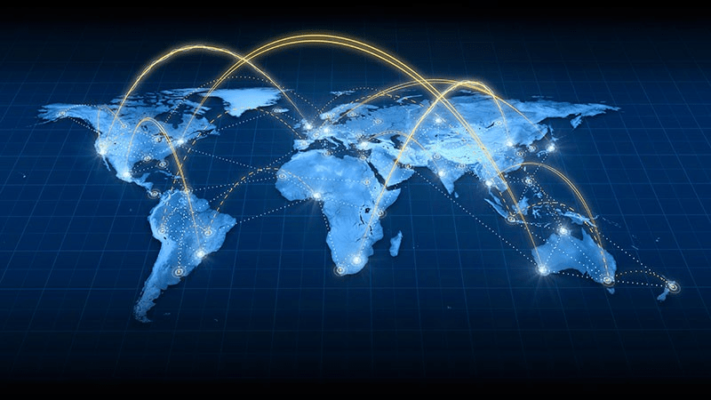
- Enhanced Resilience: A diversified supply chain offers multiple backup options in case of disruptions at any stage of the chain, decreasing the likelihood of stockouts and minimizing the impact on downstream operations.
- Improved Agility:Diversification allows businesses to respond quickly to market shifts and consumer preferences by leveraging dispersed production and sourcing capabilities across different geographical locations.
- Reduced Risk Concentration:By spreading sourcing and production activities across multiple regions, businesses can lower their exposure to country-specific risks, such as political instability, economic downturns, or natural disasters.
- Enhanced Innovation: Diversifying supplier relationships can expose businesses to new ideas, technologies, and perspectives, which will bring innovation and continuous improvement within the supply chain.
- Geopolitical Advantages: Diversification can provide access to newmarkets and talent pools, allowing businesses to leverage regional advantages and expand their global reach.
Delivering a diversified global supply chain strategy
Ready to explore supply chain diversification? Contact ET2C International at contact@et2cint.com. Our team of experts can help tailor a diversification strategy for your business, ensuring sustainable growth and success
Strategies for Diversifying Supply Chains

- Supplier Diversification:Identify and qualify multiple suppliers for each critical component or raw material to reduce dependency on any single source.
- Geographical Diversification:Expand manufacturing and distribution facilities across different regions to mitigate risks of natural disasters, political instability, or trade disruptions.
- Transportation Diversification: Utilize multiple transportation modes and routes to avoid overdependence on any single means of logistics, reducing vulnerability to transportation disruptions.
- Technology Adoption:Leverage digital technologies to gain real-time visibility into supply chain operations and optimize decision-making.
- Collaboration and Partnerships: Engage in strategic partnerships with suppliers, logistics providers, and industry peers to share best practices and collectively address supply chain challenges.
ET2C International is an Expert in Sourcing and Supply Chain
ET2C International has for over twenty years played a crucial role connecting global brands and companies with sourcing partners. Our expertise in global sourcing and supply chain can make sure you get all the benefits of sourcing from China and Asia without any of the risks.
Our 250 colleagues are based in offices in seven key Asian sourcing markets to make your global sourcing simpler. Where language, time zone or business communication practices can make things difficult, our team will be your bridge to your suppliers.
Our team of experts can help you build and deliver your diversification strategy. Giving you independent feet on the ground and confidence with fast responses, removing time zone and language challenges.
Supply chain diversification is not a one-size-fits-all strategy. The optimal approach will vary depending on the industry, product type, and risk tolerance of each organization. However, by carefully evaluating their supply chain and implementing targeted diversification strategies, businesses can enhance their resilience, agility, and competitive advantage in the ever-evolving global marketplace.
If you would like to explore opportunities or to discuss how we can help you to diversify your supply chain, please contact@et2cint.com
Global Markets, Local Risks: Why Diversifying Your Global Supply Chain Matters Read More »


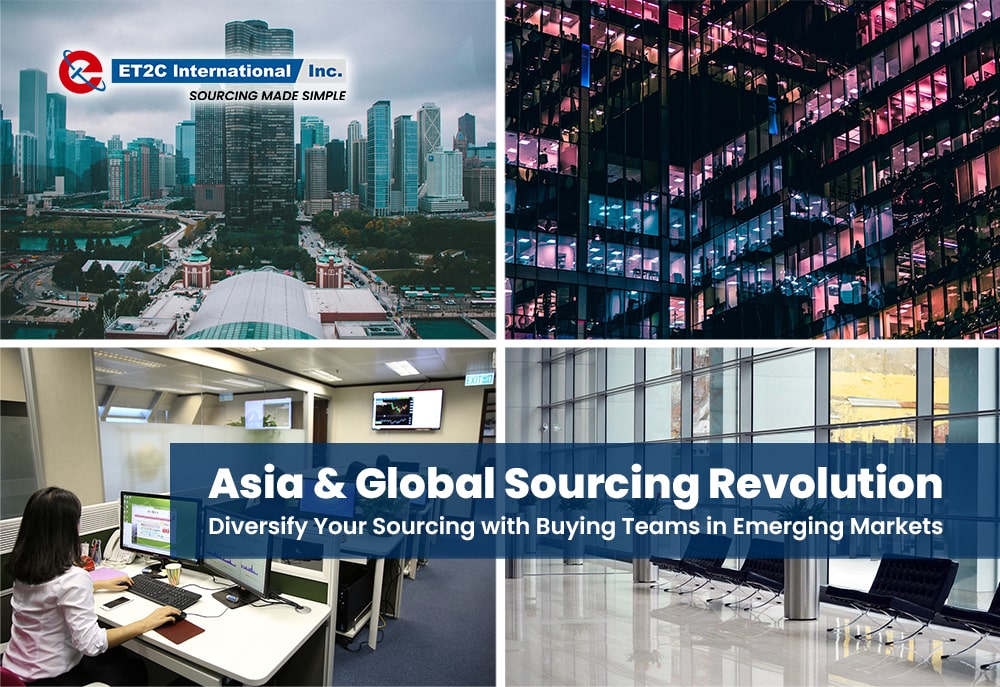



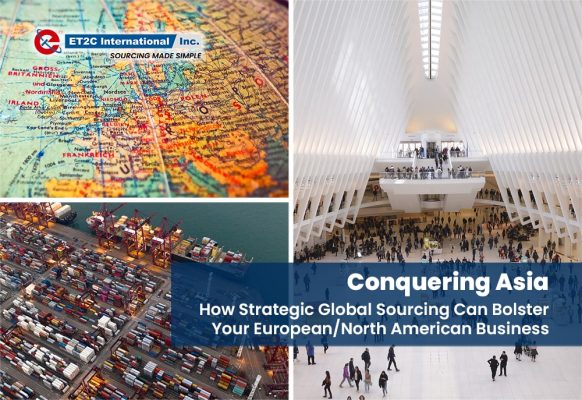 …
…